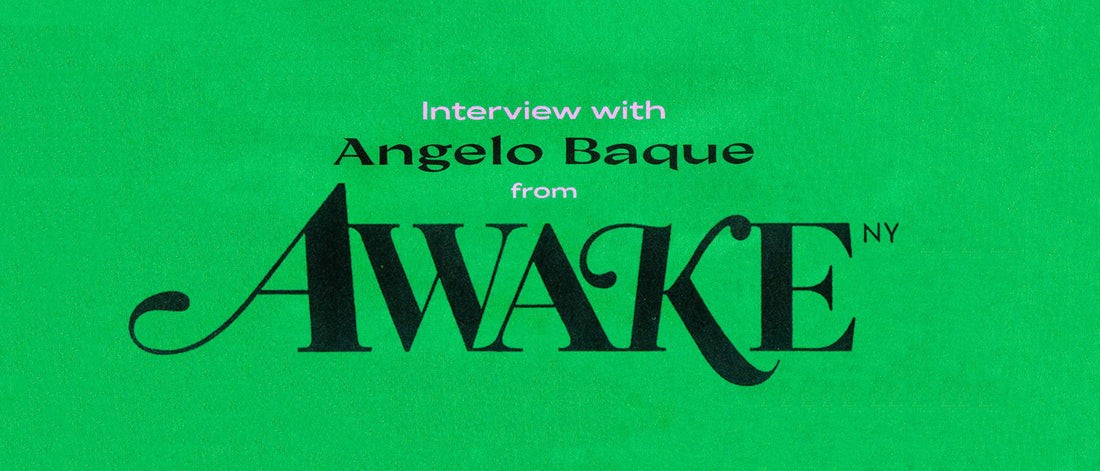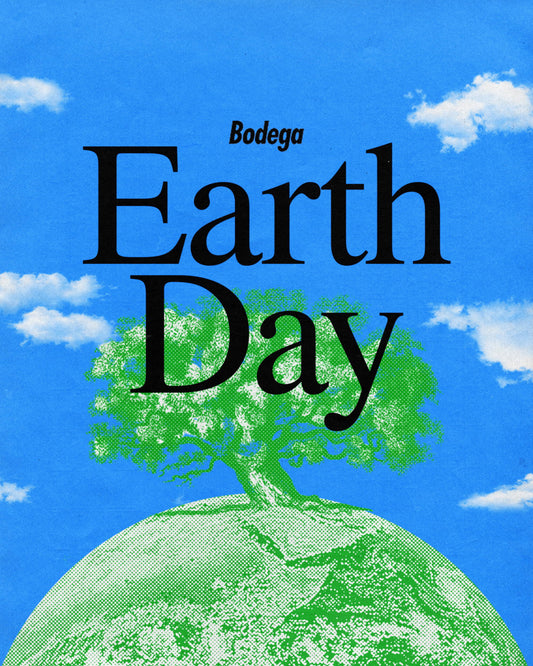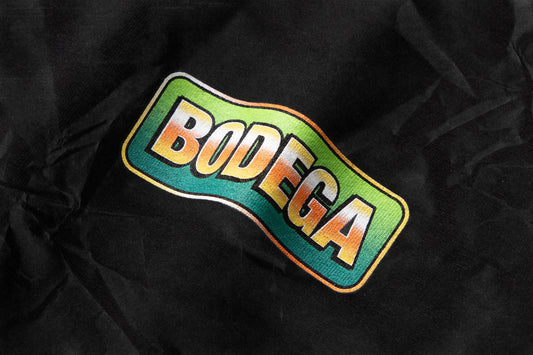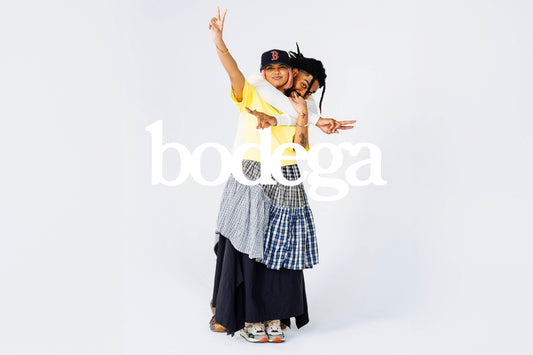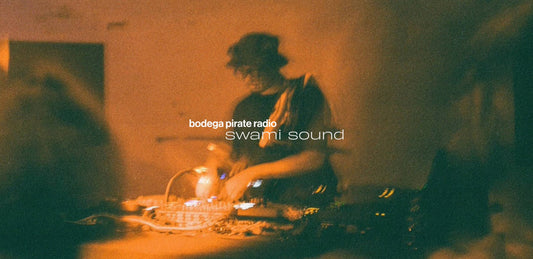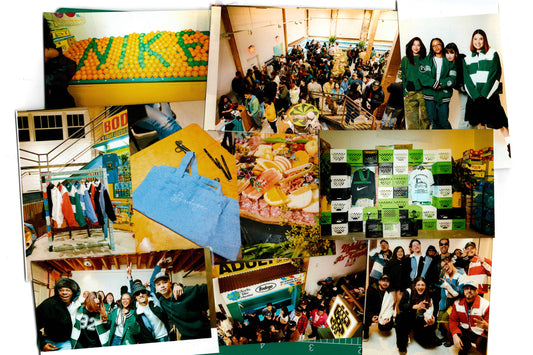Awake NY draws on the constant evolution of the New York cultural landscape that the city's unique mix of peoples and perspectives.
The assurance of familiar quality that comes with a red and white checkered table cloth at a pizza restaurant combines with an eternal openness to new ideas, as the modern streetwear sensibility that creator Angelo Baque honed as Supreme's brand director for ten years is imbibed with the timeless qualities of fashion touchstones like classic menswear and old-school sportswear. We caught up with Angel Basque on the eve of the release of his latest collection to talk about his inspirations, his New York, and the continued irrelevance of the term ‘streetwear.’
Awake NY draws on the constant evolution of the New York cultural landscape that the city's unique mix of peoples and perspectives.
The assurance of familiar quality that comes with a red and white checkered table cloth at a pizza restaurant combines with an eternal openness to new ideas, as the modern streetwear sensibility that creator Angelo Baque honed as Supreme's brand director for ten years is imbibed with the timeless qualities of fashion touchstones like classic menswear and old-school sportswear. We caught up with Angel Basque on the eve of the release of his latest collection to talk about his inspirations, his New York, and the continued irrelevance of the term ‘streetwear.’
Your collection has already been released on your site and at Dover Street Market. How has the initial reaction been?
I talked to London and they’ve had a pretty good sell through, and we’ve had a pretty good sell through as well. Awake, in a good way, doesn’t have a fuckboy following. This isn’t a Kanye or Travis Scott thing where they drop a t-shirt and it’s gone in two seconds... or like the height of Supreme. If you are really into Awake, you can actually access it. We have inventory. I think it’s priced really fairly for what it is. What I’ve always heard from returning customers is that it's a very stress-free experience. They can get what they want. It’s not a negative thing. It’s not like “oh this didn’t sell out right away; this shit is a failure.” Then again, by Day Two, the more popular things do start selling out and eventually everything does sell out which is good. It’s just not gone in 5 minutes. It's very rare when that happens, but this time around it was the Sam Friedman hat which was gone in like 2 minutes. Those things I can’t predict. I don’t know what the fuck kids want. I just try to make cool shit.
What led you to start your own label. Did you have a bunch of ideas that didn’t fit within the framework of Supreme? Did you feel you like you had learned everything you needed to know from your time there?
It’s a little bit of everything. Toward the end of my tenure at Supreme I was getting older and my tastes changed. Prior to Supreme, I worked for Nom de Guerre and my tastes started to evolve. There were different things that I wanted that I couldn’t find at Nom de Guerre or Supreme or Ralph Lauren. So that’s why I started my own brand. I had my own graphics that I wanted to make. I’ve always had my own vision, but my vision for Supreme isn’t my vision for Awake. I knew the position I played in that company. I was never the creative director of Supreme. But my ideologies change, my feelings change and the only way I can have those things come to fruition is by owning my own thing. While working at Supreme, I always made a conscious effort to do all of these side projects outside of the brand in order to keep myself creative and not get pigeonholed by the brand. And not that I always wanted to leave, but i always had an exit strategy. I always wanted to make sure that on the day I left that my name was intact, and I wouldn’t be “oh that guy who left Supreme.” It’s going to be four years since I stepped away from the brand, and I’ve created enough of a body of work that it isn’t the main focus of any conversation now. We could talk about Awake, we could talk about Social Studies, we could talk about the books I published for Shaniqwa [Jarvis] and Raphael [Rios], there’s a lot of content there. But if I hadn’t done all of these little side projects while I was at Supreme, I don’t think I would be where I am now.
When you were starting Awake, did you encounter a lot of things you didn’t anticipate when starting your own brand?
I don’t know. Technically Awake started in 2012, while I was still working at Supreme. So for me there are almost two starting points for Awake. There’s the original one from 2012 and then there’s the one from when I stepped down in 2016, where I went back to the things I was always into in the early 2000s. I went back to graphic t-shirts, I got back into hoodies. I got back into sweatpants and sneakers, you know. I was off that shit for a while. And suddenly that love affair started all over again. That got me to that point in 2016. After that, things were kind of serendipitous. I gave a hat to Virgil and he wore it and suddenly there was a demand for the brand. My objective when I left wasn’t to focus so much on building another brand. I didn’t want to have another clothing brand. You’re familiar with the retail business; it’s a lot of fucking hard work. The main focus for me was the creative agency with Baque Creative, but within a year it see-sawed toward Awake and the demand was there for Awake. I really started feeling inspired again with creating cool graphics and hats and hoodies and that kind of stuff.
You have said that Awake is, in part, a tribute to New York and its diversity. If New York is a bit of everything, does that make it easier or harder to represent and capture that diversity?
I don’t think it’s hard to capture the essence of New York through the clothes because it’s coming through my view and perspective. I don’t have to be physically in New York to feel New York or give you New York. It’s in my DNA. It’s in my accent. It’s in the way I walk; it’s in the way I talk. It’s in the way I think and the way I hustle. That kind of ethos and ideology is put into that design and presentation, which i think is very important. What we were doing almost four years ago is now the norm. I’m pretty sure it’s on every art director’s moodboard now to have certain boxes ticked for diversity and gender. We’ve been doing that shit because that’s the world I grew up in. I grew up in a world that was blended with hip-hop, skate, hardcore, gay. It wasn’t about checking certain boxes to make sure certain demographics are happy. That’s the authenticity and genuinity of the brand. That’s who I am and I’m going to stay true to who I am and get that message through the gear.
Is there a conscious decision to change things up from season to season. Are there things that link the collections thematically?
As a designer, what I understand is men. What do I want? I want a dope hoody. I want dope sweatpants, and a good hat. That doesn’t change for men. I’m not trying to make a couture suit. I’m not trying to make some Neoprene, triple-layer waterproof thing. There are so many other people out there that do that well. It’s just not me. You are just authentically getting me. I’m not trying to be anybody but myself, so I don’t ever feel the pressure of “we need to do a new silhouette. We need to recreate the hoodie.” That’s just not us. I do want to give you a dope t-shirt graphic or a dope flannel to wear. Those are things I still want. I want a cool sweater, maybe a cardigan, maybe even an Oxford shirt. It resonates with a 13-year-old and it resonates with someone our age. We all kind of want the same shit. Anyone in my position that wants to do more is just complicating their life.
Do you have any trends that you’d like to disappear?
No. no. To be honest, I’m beyond the point of hating on people and shitty style. Shitty style is subjective, and there’s enough good stuff for people to pick from, so it’s really on them. I mean, maybe face tats. I’m not sure why so many kids get face tats. You gotta get a job one day. You know what I’m saying? I don’t know about clothing, I’m very open-minded when it comes to that, but there’s just something about face tats. It’s gonna look really fucked up when you’re my age. I think the unfortunate thing is that most kids don’t see themselves as getting old. That’s the bigger conversation. They have this kind of nihilistic idea of life. I, myself, used to romanticize about dying at 27. And now that I’m 42, I’m very happy with what I have right now. And no face tats.
You mentioned timelessness when it comes to your brand's output, but have you become conscious of any changes in your designs over time.
No, when it comes, it comes. I don’t have a specific process where I take a trip to Japan for inspiration. I don’t meditate somewhere in the Catskills and come back with a collection. It depends on the day-to-day. For me, that’s why it’s still important to be in New York— to just walk around and get inspiration. When it comes, I just don’t know.
What do you even think of the term “streetwear?” Seeing it go from its inception to its many changes, does the word even mean anything anymore?
Streetwear doesn’t really mean anything to me. It was a label created by “higher-ups” to commodify this culture. Prior to this being called streetwear, this was called “Urbanwear” and back then it didn’t really have any value to luxury or department stores. It was something that was considered “inner city” or “black and brown,” and it wasn’t really affecting their bottom line. But now it’s totally the opposite. The most powerful shopper right now is that 15-16 year old, and they don’t give a fuck about the luxury brands because they’re not speaking to them. They don’t know what it means. I had to work 15 years before I could afford a Vuitton wallet. There are certain things that I hold dear that are staple pieces in my day-to-day that I had to work for. It doesn’t really mean anything anymore. A lot of that was tied to luxury and benchmarks and owning these individual pieces.

